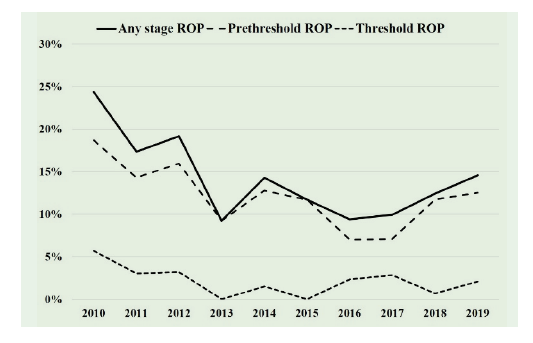Incidence and Risk Factors of Retinopathy of Prematurity, a 10-year Experience of a Single-center, Referral, Hospital
DOI:
https://doi.org/10.33192/Smj.2021.101Keywords:
Incidence, preterm infants, retinopathy of prematurity, screening, threshold diseaseAbstract
Objective: To explore the incidence and trend of ROP over the past 10 years. The secondary objective was to identify
any association between clinical variables and threshold ROP.
Materials and Methods: A cross-sectional, retrospective study of infants with <33 weeks’ gestational age (GA) or
birth weight (BW) ≤1,500g were screened for ROP between January 2010 and December 2019 Infants who had
threshold ROP, labelled as the T-group, were compared against non-threshold infants (either normal or prethreshold
ROP), or the NT-group.
Results: Of the 1,247 infants who were screened for ROP, 174 (14%) tested positive for ROP while 26 (2.1%) had
threshold ROP. Infants who had ROP had a mean ±standard deviation (SD) GA 27.2 ± 2.2 weeks and 115 (66.1%)
were <1000g at birth. Advanced GA was independently associated with lower risk of threshold ROP [adjusted odds
ratio (95% confidence interval, CI); 0.71 (0.52, 0.98), p=0.04]. There was no difference in respiratory and hemodynamic
outcomes between the T and NT-group, except for longer hospitalization (median [P25, P75]; 121[106.3, 160.5]
and 93.5[72.3, 129] days, p=0.003]. Culture-positive septicemia was independently associated with threshold ROP
[adjusted odds ratio (95% CI); 4.48 (1.72, 11.68), p=0.002].
Conclusion: The incidence of different stages of ROP in infants was 14% and 2.1% for severe ROP which required
treatment. Lower GA and positive-culture septicemia was associated with a higher incidence of severe ROP.

Published
How to Cite
Issue
Section
License
Authors who publish with this journal agree to the following conditions:
Copyright Transfer
In submitting a manuscript, the authors acknowledge that the work will become the copyrighted property of Siriraj Medical Journal upon publication.
License
Articles are licensed under a Creative Commons Attribution-NonCommercial-NoDerivatives 4.0 International License (CC BY-NC-ND 4.0). This license allows for the sharing of the work for non-commercial purposes with proper attribution to the authors and the journal. However, it does not permit modifications or the creation of derivative works.
Sharing and Access
Authors are encouraged to share their article on their personal or institutional websites and through other non-commercial platforms. Doing so can increase readership and citations.













